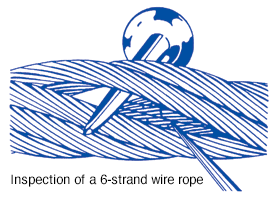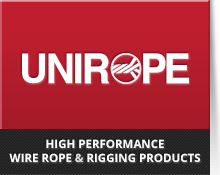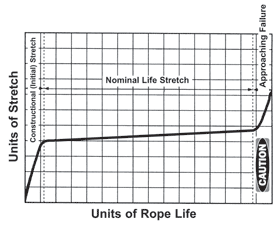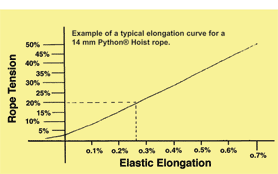Rope StretchConstructional Stretch This stretch occurs in three phases: 1) Initial or constructional stretch during the early period (Run-In) of rope service, caused by the rope adjusting to the operating conditions. 2) Following the run-in period there there is a extended period – the longest part of the ropes’s service life – during which a slight increase in stretch takes place over an extended time. This results from normal wear, fatigue etc. On a graph this portion would almost be a horizontal straight line inclined slightly upward from its initial level. 3) Thereafter, the stretch occurs at a quicker rate. This means that the rope has reached the point of rapid degradation; a result of prolonged subjection to abrasive wear, fatigue, and inner undetected wire breaks, etc. This second upturn of the curve is a warning indicating that the rope should be removed to avoid sudden catastrophic rope failures.
|
Elastic Stretch / Elastic Limit In many instances it is not easy to clearly distinguish between (the remains of) constructional stretch and elastic stretch as they may occur together especially when the rope is new. The values for Elastic Stretch are dependent on rope construction, lay length and type, steel material, tensile strength of wires etc. An approximation is 0.25% to 0.6% at WLL (or lifting capacity). The E-module varies similarily from about 11 Million to 16 Million lbs/inch2. For exact values please contact us for further information. Elastic stretch turns into a ‘permanent’ stretch when the rope is loaded beyond 55%-60% of its breaking strength (or beyond 2-1/2 to 3 times its WLL). At that point the steel material elongates and deforms permanently and renders the rope inoperable as the individual wires will have lost much of their mechanical properties to withstand material fatigue.
|
Rope Stretch, Core Wire breaks
Core Wire Breaks
The most difficult to detect wire rope deterioration. Core wire breaks are more likely to appear in 6 & 8-strand and 19×7/19×19 ropes, rather than in multi-strand plastic coated core wire rope. We have had examples where 8×36 and 19×7 ropes broke showing no externally visible removal criteria, yet the core was completely broken to pieces. Once the core breaks, the resultant sudden shock load on the outer strands may cause the rope to fail in a catastrophic, unpredictable manner.
 Core wire breaks in PYTHON® plastic coated core ropes are not likely to appear due to the cushioning effect of the plastic layer. Field experience from customer returned plastic coated core PYTHON® rope revealed no broken core wires without the outer strands having visible wire breaks in excessive numbers far beyond any removal criteria.
Core wire breaks in PYTHON® plastic coated core ropes are not likely to appear due to the cushioning effect of the plastic layer. Field experience from customer returned plastic coated core PYTHON® rope revealed no broken core wires without the outer strands having visible wire breaks in excessive numbers far beyond any removal criteria.
To inspect the core of a 6- or 8-strand wire rope, the rope must be completely unloaded. Carefully insert a spike through one or two strands and turn the spike with the rope lay. If the core is heavily lubricated you need good lighting to see broken wires! You may also wish to use a air gun to blow excessive lubricant off the core, but be sure to re-lube the core after your inspection.
As with any rotation resistant or non-rotating rope we recommend to leave such internal inspections to the expert as such inspections can permanently damage the rope.





